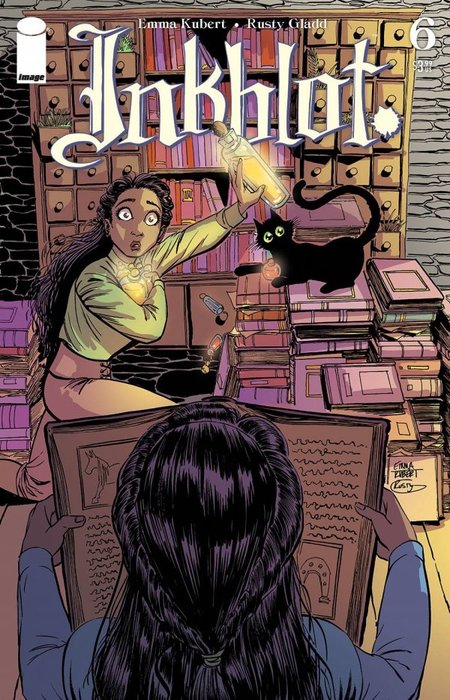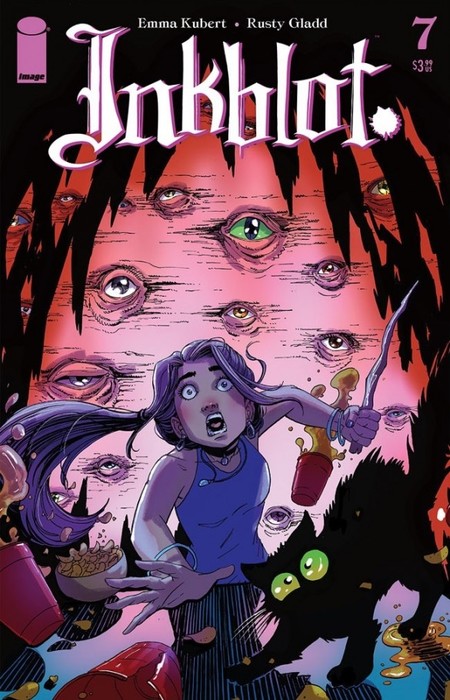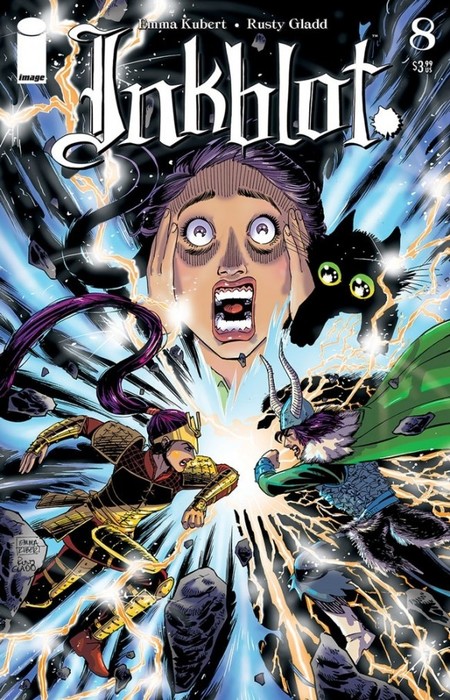If there is one thing in multitudinous abundance in the expansive, neverendingly imaginative delight that is Inkblot, in this case issues 6 through 10, it is the idea that magic does not cure all ills.
In many fantasy settings, that is precisely what it does; one wave of the hand or flick of the wrist and hey presto, all that was broken is made good again, the world set right with a simple incantation.
But that is not what happens in Inkblot (from writer/artist Emma Kubert and writer Rusty Gladd), which as the review of issues one through five underlined, never makes the case that magic will fix everything that ails you, your family or the world at large.
What it seems to do is actually make things far more complicated and when it’s not doing that, it muddies the waters so much that knowing which ways are up or down seems all but impossible.
Certainly the Seeker, who spends her days, when she’s not chasing the feline-shaped demon that is Inkblot across all of time and space, with more than a few illuminating stops along her own flawed timeline, ensconced in a cosy tree-buttressed library straight from Fantasy 101 location casting, knows that all too well.
In her decidedly unmagical world, Inkblot is often more of a typical cat than anything else as the opening page of issue 8 beautifully illustrates.
“All the power in the universe and what do you do with it?
You break everything.
You show up, scratch at the walls, defecate on the rug, and break everything …
… And here I sit, helpless, because if I try and stop you you, you’ll just zap us straight into some new form of mortal peril.
Oh, will it be emotional trauma today? Have you decided?”
And yet for all of Inkblot’s essential “cat-ness”, it is, after all is said and pushed off the desk to smash on the ground, a time and space travelling demon who seems to be doubling as the therapist from hell.
In these five action-packed, if somewhat narratively confused and scattered issues, Inkblot whisks the Seeker to a lot of places she’d rather not be or if she is not in the firing line, then one of her family members or someone entirely related is faced with a reckoning of some kind.
What emerges most powerfully from these seemingly disconnected chapters of the story is a sense that the cat, who is from the Void, a black and strange place which an elf girl in issue 10 rather sagely warns is “haunted … those who wander in never come out”, may just the cause and the solution of the chaos that follows it wherever it goes.
Being both the architect of the time and space chaos and its potential saviour makes for some mysterious storytelling and so it is that Inkblot, while a vibrant, enormously clever tale with a brilliant sense of time and place and imaginative energy to burn (with vivaciously alive artwork to match), does tend to disappear up its own cleverness at times.
There are moments where you move between issues – these five issues were effectively binged which may not be the best way to take them in – and there is a wrenching sense of narrative dislocation.
Having said that, Inkblot is overwhelmingly a sumptuously impressive and compellingly readable body of work.
The worldbuilding alone is worth the price of admission, with everything from the Void to the Seeker’s library to the lands in which the Seeker and her siblings live and rule, bursting from the page, thanks to inspired artwork and evocatively articulate dialogue and storyline.
But beyond that, there is a deep and abiding emotional resonance to Inkblot which gives a rich humanity to each of the separate but interlinked tales.
The Seeker’s frustration at what or who the cat is, and why it is doing what it does, is palpable and you can well understand how someone who has dedicated their life to understanding the world or worlds around them, might find the willfully mischievous enigma that is Inkblot a confounding frustration.
Similarly the awed sense of being overwhelmed that the elf girl in issue 10 evinces, along with with her vulnerability and her simultaneous sense of knowingness, makes her a character with whom it’s easy to identify, despite the fantastical surrounds of her instalment.
It’s this rich, raw characterisation that gives so much emotional impact to a fantasy tale that is cheekily over the top yes and full of some marvellous moments of humour, but also soberingly dark and all too real, full of power plays, sibling rivalry, broken worlds and relationships which for all his chaos inducing behaviours may only be solved by the enigmatic weird, hilarity of Inkblot.
Full marks to Kubert and Gladd for going all out on the imagination, the humanity, the vividly-realised artwork and the energising sense of being transported somewhere utterly remarkable which also feels feel grounded, real and something with which we can all identify.


